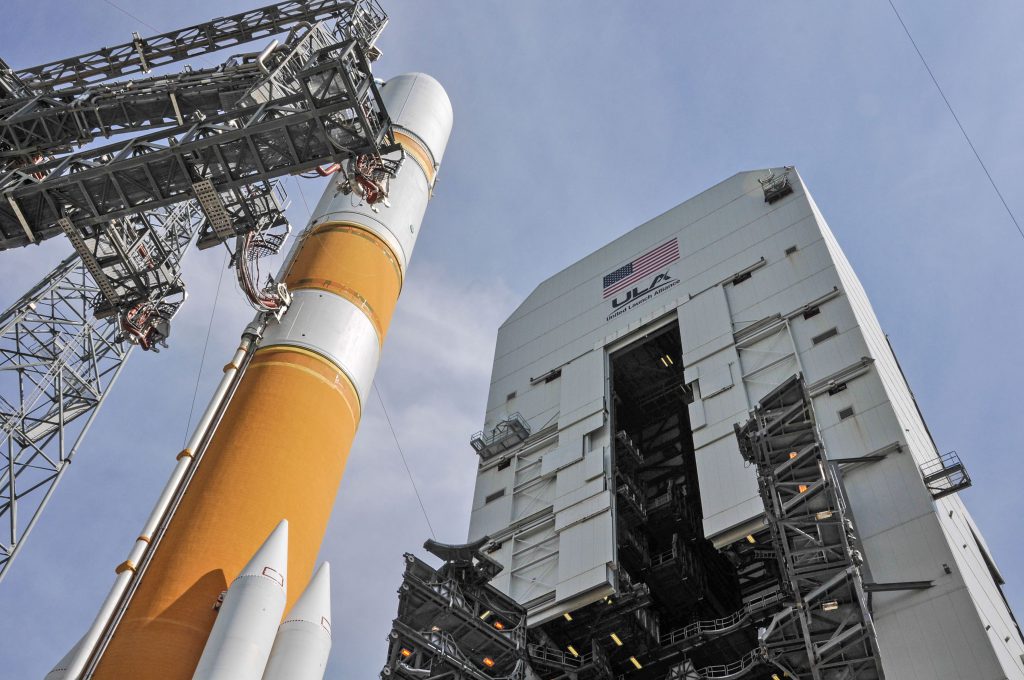

A Delta 4 rocket will launch the WGS 8 satellite on Wednesday. Credit: United Launch Alliance
Go Delta IV! Go WGS-8!
Official Mission Page:http://www.ulalaunch.com/delta-iv-to-launch-wgs8.aspx?title=Delta+IV+to+Launch+WGS-8
Live broadcast:http://www.ulalaunch.com/webcast.aspx
Rocket/Payload: A United Launch Alliance Delta IV Medium+ (5,4) configuration will launch the eighth Wideband Global SATCOM (WGS-8) mission for the U.S. Air Force.
Date/Site/Launch Time: Wednesday, Dec. 7, 2016, from Space Launch Complex-37 at Cape Canaveral Air Force Station, Florida. The launch widow is 6:53-7:42 p.m. EST.
Live Broadcast: ULA’s live launch broadcast will begin at 6:33 p.m. EST.
Mission Description: WGS satellites are important elements of a high-capacity satellite communications system providing enhanced communications capabilities to America's troops in the field for the next decade and beyond. WGS enables more robust and flexible execution of Command and Control, Communications Computers, Intelligence, Surveillance, and Reconnaissance (C4ISR), as well as battle management and combat support information functions. The WGS constellation augments the existing service available through the UHF Follow-on satellite by providing enhanced information broadcast capabilities.
Launch Notes: WGS-8 will mark the sixth flight in the Medium+ (5,4) configuration; all launches in this configuration were WGS missions.
Latest News Update:
Upgraded satellite for communications among U.S. military forces ready to launch
CAPE CANAVERAL — The backbone of the U.S. military’s global communications network, relied upon by soldiers, ships, jets, aerial drones and allied nations around the world, will receive a new satellite with unprecedented capacity following its launch Wednesday atop a Delta 4 rocket.
The Wideband Global SATCOM satellite No. 8, a $426 million investment by the Pentagon and built by Boeing, will be boosted into space by the United Launch Alliance rocket from Complex 37 at Cape Canaveral.
Liftoff is planned for 6:53 p.m. EST, the opening of a 49-minute launch window that extends to 7:42 p.m. EST (2353-0042 GMT).
Weather forecasters predict an 80 percent chance of favorable conditions for the launch. They are calling for broken low-level and high cloudiness, good visibility, light northwesterly winds and a temperature of 69 degrees F.
Flight Profile:
T-00:05.0 Engine start

The RS-68A main engine begins to ignite as the liquid hydrogen fuel valve is opened, creating a large fireball at the base of the rocket. The engine powers up to full throttle for a computer-controlled checkout before liftoff.
T-00:00.0 Liftoff

The rocket’s four strap-on solid rocket motors are lit, the four hold-down bolts are released and the Delta 4 lifts off from Cape Canaveral’s pad 37B. The pad’s three swing arms retract at T-0 seconds.
T+00:46.2 Max-Q

The vehicle experiences the region of maximum dynamic pressure. The solid motors and the RS-68A liquid hydrogen/liquid oxygen engine continue to fire as the vehicle heads downrange, arcing over the Atlantic along a 93.46-degree flight azimuth.
T+01:40.0 Jettison solid motors

Having used up all their solid-propellant and experienced burnout eight seconds ago, the two strap-on boosters with fixed nozzles are jettisoned from the Delta’s first stage, followed two seconds later by the pair of boosters with steerable nozzles.
T+03:14.4 Jettison payload fairing

The five-meter diameter composite payload fairing that protected the WGS 8 cargo atop the Delta 4 during the atmospheric ascent is no longer needed, allowing it to be jettisoned in two halves.
T+03:56.0 Main engine cutoff

The hydrogen-fueled RS-68A rocket engine completes its burn and shuts down to complete the first stage of flight.
T+04:02.0 Stage separation

The Common Booster Core first stage and the attached interstage are separated in one piece from the Delta 4’s upper stage. The upper stage engine’s extendible nozzle drops into position as the first stage separates.
T+04:15.0 Second stage ignition

The upper stage begins its job to place the WGS 8 satellite into space with the first of two firings by the RL10B-2 liquid hydrogen/liquid oxygen engine.
T+19:51.8 Upper stage shutdown

The RL10 upper stage engine shuts down to complete its first firing of the launch. The rocket and attached satellite reach a parking orbit.
T+29:26.6 Restart upper stage

After a short coast period, the upper stage is reignited to raise the orbit to the planned altitude for deploying the payload.
T+32:33.6 Upper stage shutdown

The powered phase of the Delta 4’s mission to loft WGS 8 concludes. The second burn will reach the planned super-synchronous orbit of 270 by 27,575 statute miles with an inclination of 27 degrees.
T+41:43.6 Separate spacecraft

The Wideband Global SATCOM 8 military communications satellite is released into space from the Delta 4 rocket. The Boeing-built satellite will use its onboard propulsion to reach geostationary orbit where it will match Earth’s rotation and appear fixed above the equator in the WGS constellation.
Gallery:
The U.S. Air Force's eighth Wideband Global SATCOM (WGS) satellite, encapsulated in a 4-meter payload fairing, is mated to a Delta IV booster at Cape Canaveral Air Force Stations's Space Launch Complex (SLC)-37.






(Note: I won't be around for the next few days and I will be back by Sunday, so no live launch coverage for the next few days. I wish all launches that follow will be successful. Good luck!:thumbup
